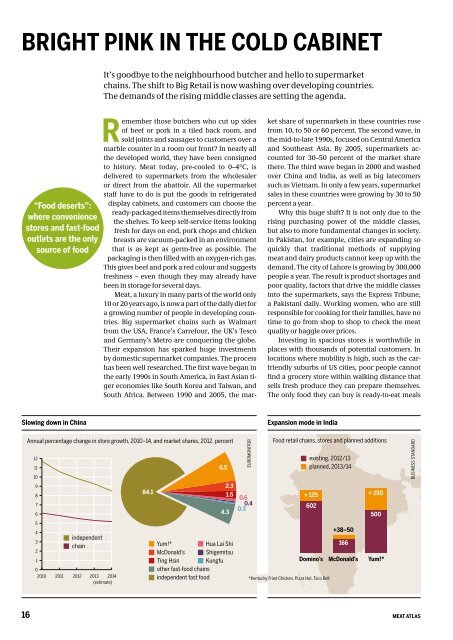1jjtwKx
1jjtwKx
1jjtwKx
Create successful ePaper yourself
Turn your PDF publications into a flip-book with our unique Google optimized e-Paper software.
BRIGHT PINK IN THE COLD CABINETIt’s goodbye to the neighbourhood butcher and hello to supermarketchains. The shift to Big Retail is now washing over developing countries.The demands of the rising middle classes are setting the agenda.“Food deserts”:where conveniencestores and fast-foodoutlets are the onlysource of foodRemember those butchers who cut up sidesof beef or pork in a tiled back room, andsold joints and sausages to customers over amarble counter in a room out front? In nearly allthe developed world, they have been consignedto history. Meat today, pre-cooled to 0–4°C, isdelivered to supermarkets from the wholesaleror direct from the abattoir. All the supermarketstaff have to do is put the goods in refrigerateddisplay cabinets, and customers can choose theready-packaged items themselves directly fromthe shelves. To keep self-service items lookingfresh for days on end, pork chops and chickenbreasts are vacuum-packed in an environmentthat is as kept as germ-free as possible. Thepackaging is then filled with an oxygen-rich gas.This gives beef and pork a red colour and suggestsfreshness – even though they may already havebeen in storage for several days.Meat, a luxury in many parts of the world only10 or 20 years ago, is now a part of the daily diet fora growing number of people in developing countries.Big supermarket chains such as Walmartfrom the USA, France’s Carrefour, the UK’s Tescoand Germany’s Metro are conquering the globe.Their expansion has sparked huge investmentsby domestic supermarket companies. The processhas been well researched. The first wave began inthe early 1990s in South America, in East Asian tigereconomies like South Korea and Taiwan, andSouth Africa. Between 1990 and 2005, the marketshare of supermarkets in these countries rosefrom 10, to 50 or 60 percent. The second wave, inthe mid-to-late 1990s, focused on Central Americaand Southeast Asia. By 2005, supermarkets accountedfor 30–50 percent of the market sharethere. The third wave began in 2000 and washedover China and India, as well as big latecomerssuch as Vietnam. In only a few years, supermarketsales in these countries were growing by 30 to 50percent a year.Why this huge shift? It is not only due to therising purchasing power of the middle classes,but also to more fundamental changes in society.In Pakistan, for example, cities are expanding soquickly that traditional methods of supplyingmeat and dairy products cannot keep up with thedemand. The city of Lahore is growing by 300,000people a year. The result is product shortages andpoor quality, factors that drive the middle classesinto the supermarkets, says the Express Tribune,a Pakistani daily. Working women, who are stillresponsible for cooking for their families, have notime to go from shop to shop to check the meatquality or haggle over prices.Investing in spacious stores is worthwhile inplaces with thousands of potential customers. Inlocations where mobility is high, such as the carfriendlysuburbs of US cities, poor people cannotfind a grocery store within walking distance thatsells fresh produce they can prepare themselves.The only food they can buy is ready-to-eat mealsSlowing down in ChinaExpansion mode in IndiaAnnual percentage change in store growth, 2010–14, and market shares, 2012, percent121110987654321independentchain02010 2011 2012 2013 2014(estimate)84.1Yum!*McDonald’sTing Hsinother fast-food chainsindependent fast food6.52.31.54.3Hua Lai ShiShigemitsuKungfuEuromonitor0.60.40.3Food retail chains, stores and planned additionsexisting, 2012/13planned, 2013/14+ 125602*Kentucky Fried Chicken, Pizza Hut, Taco Bell+38–50166+ 250500Domino’s McDonald’s Yum!*Business Standard16MEAT ATLAS


